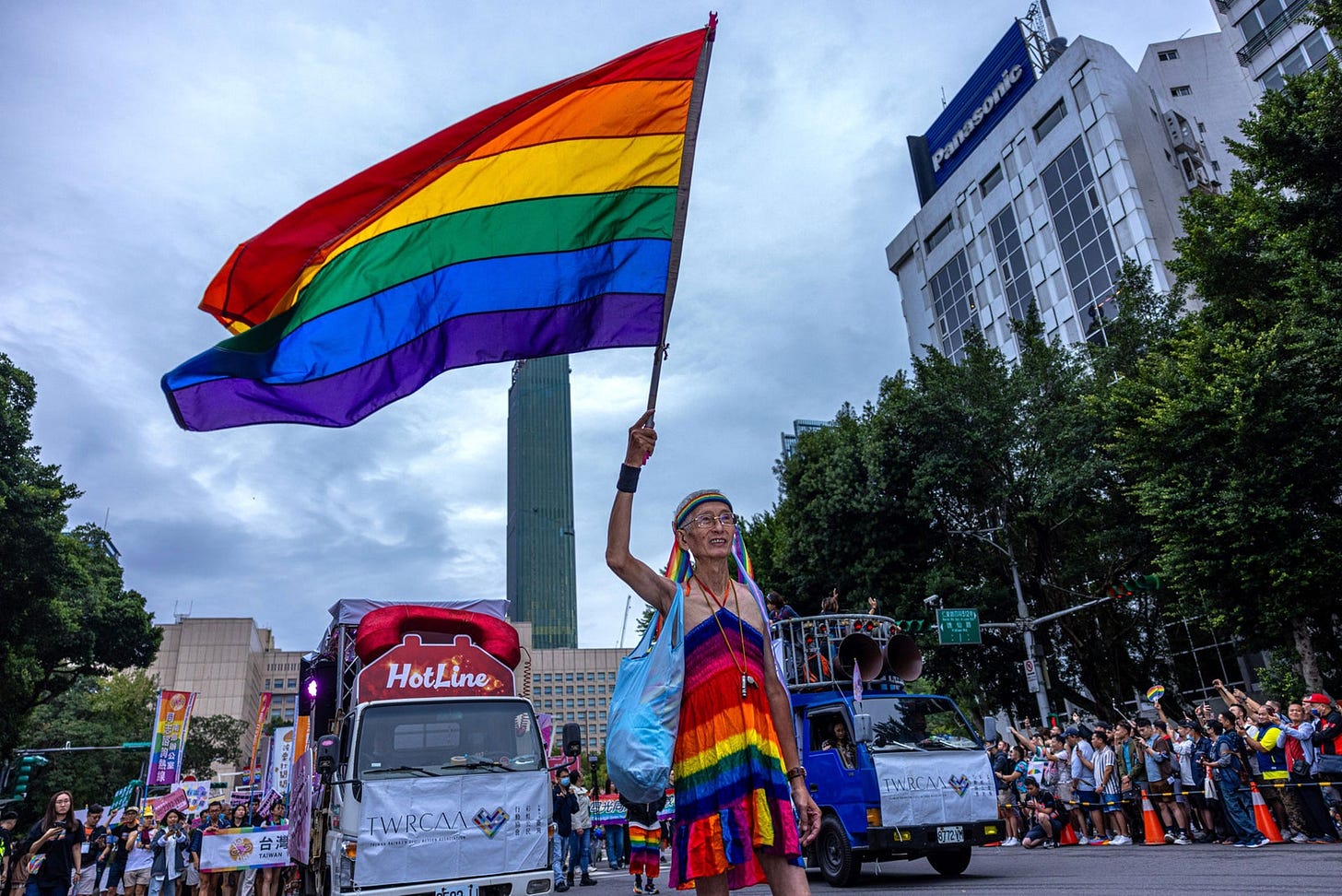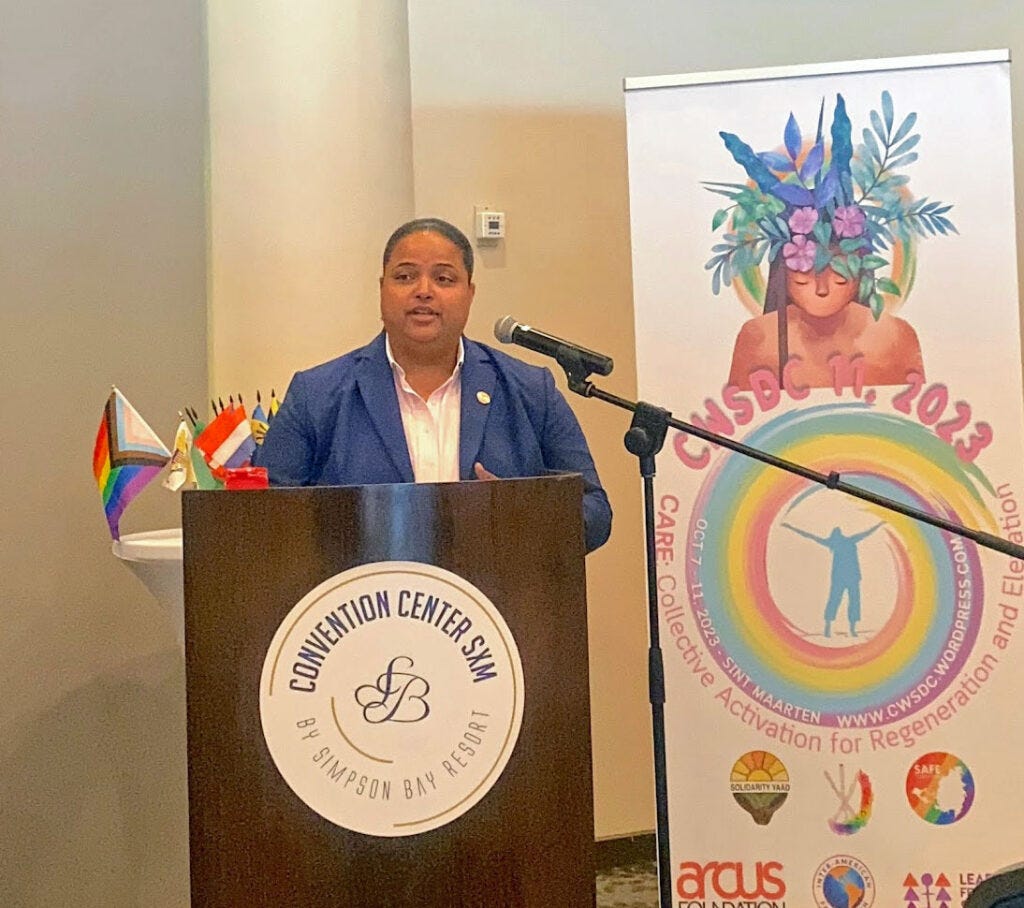Global Roundup: Gaza Woman’s Story of Loss, Taiwan Pride, Global Collection Uplifting Girls’ Resistance & Activism, Caribbean LBTQ Conference, Indigenous Grandmas Rap Song
Curated by FG Contributor Samiha Hossain
Extensive destruction is seen in the Gaza strip following Israeli airstrikes on 10 October 2023. Photo: WHO.
In southern Gaza, 34-year-old Amani is working to protect her family from the effects of Israel’s ongoing attacks and mourning the loss of a close friend. Amani works as a psychotherapist in the Gazan Ministry of Health. Her mission is to provide support to patients processing the traumas of living amid years of violence. But she also carries the heavy burden of protecting her own family.
In every single moment, an eerie uncertainty surrounds us. I live in continuous fear of what could happen to my children and family. My primary responsibility is to offer unwavering support, but the sheer gravity of this duty is crushing. -Amani
Amani had lost contact with Lamia, a 28-year-old woman who was her closest friend. Amani recalls her as a “vibrant, quick-witted, and resolute soul”, and “an embodiment of Palestinian women’s boundless strength and dreams”. Together, they worked through their master’s degree exams and dreamed of securing a scholarship for a Ph.D. programme.
When Israeli forces ordered about 1 million people relocate from northern Gaza in anticipation of a ground invasion, Amani sent messages to her friend. She feared that Lamia, like many people in the region, was unable to leave either due to physical constraints or the dangers of relocation amid the attacks. She messaged Lamia and called her repeatedly but was only met by silence and hampered by cuts to internet access.
As night fell on 14 October, a person who saw her social media post delivered the devastating news: Lamia and her entire family had been entombed under the rubble of their home after it was hit by an airstrike. In the hours that followed, Lamia’s neighbours worked for hours to excavate them from the rubble, and prayed for their lives, but the family had not survived. Thinking back at the last time she spent with her friend, Amani recalls a few days before the conflict when she and Lamia attended a seven-day self-care training program, calling it, “an experience I could never have imagined would mark our final moments together”.
I clung to the hope that Lamia might emerge unscathed, but Lamia was lost to us. With her gone, I mourned the dreams we had woven together. Our shared vision of the future, all of it, had crumbled to dust. -Amani
Annabelle Chih/Getty Images
Nearly 180,000 people filled the streets of Taipei last weekend in what was reportedly East Asia’s largest-ever LGBTQ+ Pride parade. Attendees both local and international waved rainbow flags and sported their most glamorous costumes and drag. The event organizer, Taiwan Rainbow Civil Action Association (TRCAA), said this year’s theme was “recognizing the diversity of every person, and respecting and accepting different gender identities.”
Taiwan is a diverse country, but sometimes our understanding can be limited by binary thinking, such as male and female. This dichotomy can marginalize or generate animosity between different groups. -Brian Cragun, TRCAA spokesperson
East Asia’s reportedly largest-ever Pride march, which increased its attendance from 120,000 last year, featured drag performances, a diversity-themed coloring book station, and a “Rainbow Market” with 120 vendors, the most in the event’s history. The celebration comes on the heels of a May victory that granted LGBTQ+ couples the right to adopt but the parade has long been the largest of its kind across East Asia, setting a new attendance record this weekend.
With a hotly contested presidential election slated for January, there appeared to be a distinct whiff of electoral politics at the event as well, as several of Taiwan’s major parties attended the parade to express their support for LGBTQ+ rights. Vice President Lai Ching-te of the Democratic Progressive Party (DPP), who is currently the presidential election’s frontrunner, marched behind a banner that read “Democracy Supports Gays,” becoming the highest-ranking government official to ever attend Taiwan Pride and the only presidential candidate in attendance this year.
Illustration from Stories of Girls’ Resistance. VIDUSHI YADAV, ARTIST
A website and book called Stories of Girls' Resistance is the largest global collection of oral and narrative history of adolescent girls’ activism, which brings together over 150 individual stories from girls, women, and non-binary people ages 11 to 70 from over 90 countries across the world. It was initially created by Dr. Ramatu Bangura, executive director of the Children’s Rights Innovation Fund, Rosa Bransky, cofounder and co-CEO of Purposeful, and Jody Myrum, co-founder of Our Collective Practice, senior strategist at Purposeful and fellow at Shake the Table.
Girls are positioned as passive victims in need of saving or as heroines standing up against all odds in a single act of defiance. These narratives are radically different from girls’ lived experiences and disconnect them from their power and the resistance strategies they use daily to navigate the world around them. -Jody Myrum
Seeing that the existing inaccurate narratives were driving resources and support structures that were failing girls, Bangura, Bransky and Myrum wanted to provide a counter narrative, “one deeply grounded in the stories of girls across time, place, identity and social justice struggles,” says Bransky.
We wanted to capture a wide range of stories and experiences that would celebrate girls and their power. We wanted to capture the complexity, beauty, resilience, resourcefulness and mundanity of girls' lives and resistance as a starting point for shaping the work we seek to do with and for them. -Ramatu Bangura
Through a multi-year process, Bangura, Bransky and Myrum, along with project team member Ruby Johnson, partnered with 12 story curators across nine regions of the world who are deeply connected to girls' work to collect the stories. Curators focused on ensuring people from diverse countries and underrepresented groups—including Black and Indigenous women and girls of color and queer and non-binary people—had space to tell their stories. Through collective analysis sessions, the team skillfully weaved the stories together and worked with illustrators who created vibrant artwork to help bring the stories to life. The website invites visitors to explore both this collective analysis and the unique ways in which each region brought each individual story to life through poetry, written word, theater and beyond.
Bangura, Bransky and Myrum emphasized that this body of work is only the beginning. They hope that their work serves to energize young activists and encourage people in power to integrate girls in key decision making.
We see this as part of a much larger political project to transform people’s understanding of girls’ resistance and what this means for their work. We want people to read the stories, and then do something different as a result. -Rosa Bransky
Sint Maarten MP Melissa Gumbs welcomes conference-goers.
More than 70 activists from 18 countries gathered last month in Sint Maarten to focus on the needs of lesbian, bisexual, transgender and queer (LBTQ) people assigned female at birth. The 11th Caribbean Women and Sexual Diversity Conference (CWSDC) provided a platform for sharing experiences, knowledge and strategies outside of conference-room walls.
The four-day gathering on October 7-11 touched on trauma (particularly insidious trauma), invisibility and discrimination, familial rejection, lack of access to health services, and a dearth of legal and social protections. This conference included unconventional seating, highly interactive knowledge exchange, sessions that went beyond expected conference topics and participant engagement based on the principles of open-mindedness and co-creation. The conference also focused on self-care and community safe-keeping, seeking to develop systems that genuinely care for the needs of people affected by trauma, oppression, and intersectional discrimination
The event was organized by the Eastern Caribbean Alliance for Diversity and Equality (ECADE), an independent umbrella of human rights organisations, and co-organised by Solidarity Yaad International, an intentional learning community, with input from independent activists. It was hosted by the local organisation SAFE SxM, a platform for LGBT people and their allies to engage in meaningful conversations.
It’s a privilege to host the Caribbean Women and Sexual Diversity Conference over so many years. The conference provides an important platform for Caribbean activists and we are committed to continue to work with our partners to ensure that the Caribbean LBTQ+ women and people assigned female at birth can live in safety and dignity. - Kenita Placide, executive director of ECADE
Geraldine (Gramma) Shingoose, Zoey Roy, Chickadee Richard and Vivian Ketchum created the song Ogichidaa, which addresses the people pushing for a landfill search to find the remains of two First Nations women in Manitoba. (Submitted by Zoey Roy - image credit)
Three grandmothers from Winnipeg, Canada are using rap music to advocate for the search of a landfill north of the city, where the remains of two First Nations women are believed to be. Police believe the two women—Morgan Harris and Marcedes Myran—were among four killed by one man, and that Harris's and Myran's remains were taken to Prairie Green landfill, north of Winnipeg, in May 2022. Calls for a landfill search have been made since police shared that information the following December. However, the Canadian government has not approved a search citing high costs and hazards to searchers’ safety.
Grassroots Grannies is made up of three Winnipeg women: Vivian Ketchum, Geraldine (Gramma) Shingoose and Chickadee Richard. Their song, Ogichidaa, is the first release of a national seven-part series called the Medicine Songs Project. The lyrics of Ogichidaa, which means "warrior" or "big-hearted person" in Anishinaabemowin, addresses Missing and Murdered Indigenous Women and Girls (MMIWG) as well as the people pushing for a landfill search to find the remains of Morgan Harris and Marcedes Myran. "Search the land, bring them home. This is our heart's demand," the lyrics of Ogichidaa say, followed by: "Don't let me die."
Ketchum, a longtime community advocate, says Ogichidaa was a different way for the grandmothers to express their message and show support for family members of Harris and Myran, whom they have been in close contact with since calls for the landfill search began. The recording process got emotional because the piece meant so much to the three grandmothers, Ketchum said. The song is also a tribute to the Indigenous children who did not return home from residential schools, she said.
It's really heartbreaking to see the heartbreak of the family members. -Vivian Ketchum
Zoey Roy, a Cree-Dene and Métis poet and creative producer of the Medicine Songs Project, met with the three grandmothers over five weeks last summer to help shape Ogichidaa. Created in the spirit of community building and protest, Roy said she hopes the song speaks to younger people. Shingoose said it was "very empowering" to sing the song with Ketchum and Richard.
We had powerful moments, but we also had a lot of laughter, too — and happy tears — sad ones, too. I know people will get emotional … and that's OK. It's speaking the truth about our women that are in the landfill. - Geraldine (Gramma) Shingoose
Ketchum's, Richard's and Shingoose's song shows that MMIWG is an issue that goes beyond the landfill search and Winnipeg, Roy said.
They're showing us that this issue that they're facing in Winnipeg is not an isolated issue but a part of a larger strategy of genocide. -Zoey Roy
Samiha Hossain (she/her) is an aspiring urban planner studying at Toronto Metropolitan University. Throughout the years, she has worked in nonprofits with survivors of sexual violence and youth. Samiha firmly believes in the power of connecting with people and listening to their stories to create solidarity and heal as a community. She loves learning about the diverse forms of feminist resistance around the world.






